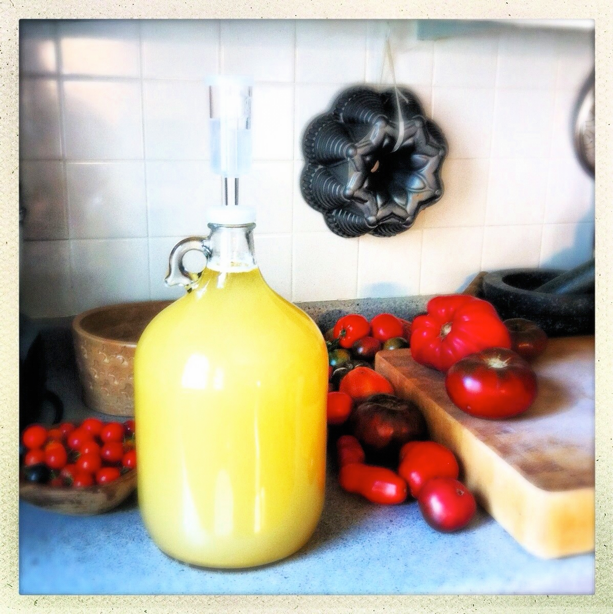
Adapted from a recipe in The Joy of Home Winemaking, by Terry A. Garey
Ingredients:
5 lbs yellow heirloom tomatoes
2 lbs sugar
1 tsp yeast energizer or 25 yellow raisins
1/4 tsp tannin or 1 black tea bag
juice of 2 lemons
2×1” strips lemon zest
1 bunch lemon verbena
1 bunch thyme
1 gallon water
1 campden tablet
1 package Montrachet wine yeast
Equipment:
2 gallon plastic fermenting bucket with airlock
1 gallon glass bottle with airlock
nylon straining bag or cheese cloth
funnel
auto syphon
StarSan sanitizer
vodka
Instructions:
Clean all of your equipment, buckets, bottles, countertops, knives, spoons, etc (anything that will come into contact with the wine during the process) with dish soap and hot water, and rinse well. Then rinse everything, including surfaces, with either StarSan sanitizing solution (per package directions) or a very week solution of 1 tbs bleach to 1 gallon of water. Leave wet and/or air dry. Make sure your hands are clean, too!
Wash your tomatoes well, making sure they are free of dirt, mold and debris. Cut out any bruises or bad spots, core and dice. Leave the peels on. Line your fermenting bucket with cheese cloth or the nylon straining bag. To it add the tomatoes, tea bag (if not using tannin), raisins (if not using yeast energizer), lemon zest, and herbs. Tie the cheese cloth or bag tightly so there are no holes and place in the fermenting bucket. With clean hands or a sanitized masher, squish the bag of tomatoes. It’s OK if pulp comes out. You’re just trying to keep the skins, seeds and big stuff in the bag.
Bring 1 gallon of water to a boil with the sugar. Pour over everything in the fermenting bucket. Put the lid on and let cool. Add the lemon juice, yeast energizer, tannin and crushed campden tablet and stir well. This brew in your bucket is now called wine “must.” Prep your airlock by filling it with StarSan solution or vodka. Put the lid on the bucket, add the airlock and let it sit for 24 hours until the campden dissipates.
(A word on Campden tablets. Campden creates a sulfur gas in your wine must that kills wild yeast and bacteria, and also bonds to chlorine in water, removing it so there is no off taste. Campden has been used in commercial winemaking and beer brewing for years. It’s perfectly safe and organic, but if you’re sensitive to sulfur, don’t use it. Just know that you run the risk of wild things in your batch that may turn it to vinegar. Not bad, but not wine either.)
After 24 hours, open the lid and add your wine yeast. Stir with a clean spoon. Close the bucket back up, add the airlock and swirl the juice in the bucket for a few minutes to aerate it. Yeast needs lots of oxygen, so this helps it out. Place the bucket in a location that’s around 68-72 degrees. Fermentation should start within 24 hours. You’ll know because your airlock will start bubbling up gasses that smell very pleasant. Fermentation at proper temp should take about 1-2 weeks.
When fermentation has subsided and your airlock barely bubbles (maybe once a minute) you need to “rack” your wine. This basically means removing the liquid from the sediment. Open the bucket and take out the bag of tomato pulp. Resist the urge to squeeze! Just let the liquid drain a bit and remove. Prepare your 1 gallon glass bottle with an air lock (make sure it’s washed and sanitized!). Using either an auto syphon (fabulous, inexpensive equipment to have) or by very carefully pouring or ladling the wine through a funnel, decant the wine from the sediment into the glass bottle. This is called your “secondary fermentation.” Taste the wine, just to see where it’s at. Mine was pretty harsh and boozy, but still had interesting flavors going on and is a good comparison for later. Add your lid and airlock filled with StarSan solution or vodka. The airlock is there just in case a little fermentation is still occurring.
Your wine should be stored in a cool dark place for at least 6 month. You may want to rack your wine again into another glass bottle if lots of sediment accumulates. The wine will continue to clear as it ages. Taste it periodically to see if you like it yet. If not, put it back in storage. I’ve been told that it really gets better with time. When you decide it’s ready, you can bottle it, or you can just place a regular clean screw cap on your bottle and use as needed. Please note that wine and oxygen don’t mix. Oxidized wine can become vinegar. So if you choose to drink your wine from the bottle, you may want to have some smaller bottles handy to pour off the unused wine to reduce it’s exposure to oxygen. A great guide to all things brewing beer and winemaking, including bottling, can be found at Northern Brewer’s video library.